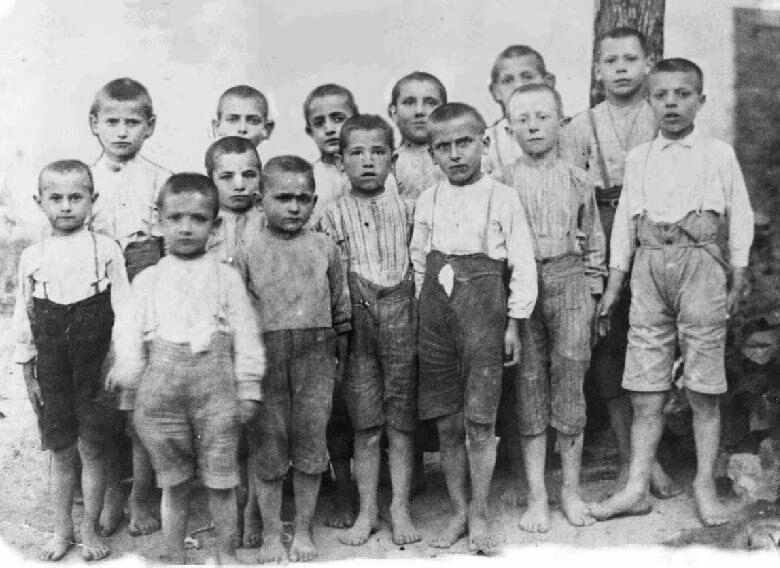
Cittą di Castello Catholic Charity School

Figure 1.--This photo was taken in Cittą di Castello, a big village in central Italy, during 1910s. It shows a group of pupils of the local catholic primary school. This school was a charity institution for children of poor families, founded in 1910. For this reason, the pupils are not required to wear any uniform. The boys are wearing their everyday clothing: trousers with suspenders and shirt. Because they belong to poor families, all the boys are also barefoot.
|
|
This photo was taken in Cittą di Castello, a big village in central Italy, during 1910s. It shows a group of pupils of the local catholic primary school. This school was a charity institution for children of poor families. It was founded in 1910 by Carlo Liviero, the Catholic bishop of Cittą di Castello, a big village (or little town) of about 40,000 inhabitants in central Italy. The school was not an orphanage, but a private primary school. It was, however, not attended by children of affluent families; it was a school for poor families.
At the time Kingdom of Italy had laws about compulsory school attendance, but many children didn't attend. About 50 percent of Italians were still illiterate.
We are not entirely sure why a charity school was needed. There was a state primary school in Cittą di Castello.
I don't know if at the time there were other private schools. In the town of Perugia, about 50 km south of Cittą di Castello, there were more schools; also a catholic residential school attended by children of affluent families.
At state schools the dress code were stated by the local authorities. Usually the dress code were not very strict, but sometimes included mandatory shoes. The school accessories (exercise-books, pencils...) had to be purchased by the family. It is true that no child could be refused for uniform lacks, and poor families could require a free supply of exercise-books and pencils. However many poor families could be shamed by asking for assistance.
Another aim of the Bishop could be to offer Catholic education in a region where Socialism and Anarchism were very strong. Before the "Concordato" (1929) Catholic Church was distrustful about state schools.
As the children came from poor families, the pupils were not required to wear any uniform. The boys are wearing their everyday clothing: trousers with suspenders and shirt. Because they belong to poor families, all the boys are also barefoot.
HBC-SU

Related Chronolgy Pages in the Boys' Historical Web Site
[The 1900s]
[The 1910s]
[The 1920s]
[The 1930s]
[The 1940s]
[The 1950s]
[The 1960s]
[The 1970s]
Navigate the Relate Boys Historical Clothing Style Pages
[Long pants suits]
[Short pants suits]
[Lederhosen]
[Kneesocks]
[Eton suits]
[Jacket and trousers]
[Blazer
[School sandals]
Navigate the Boys' Historical Clothing School Uniform Pages
[Return to the Main religious school page]
[Return to the Main Italian School Type Page]
[Return to the Main School Uniform national page]
[Australia]
[England]
[France]
[Germany]
[Ireland]
[Italy]
[Japan]
[New Zealand]
[Scotland]
[United States]
Navigate the Boys' Historical Clothing Web Page
[Introduction]
[Activities]
[Biographies]
[Chronology]
[Cloth and textiles]
[Clothing styles]
[Countries]
[Topics]
[Bibliographies]
[Contributions]
[FAQs]
[Glossaries]
[Images]
[Links]
[Registration]
[Tools]
[Boys' Clothing Home]
Created: 5:02 AM 12/26/2008
Last updated: 1:28 PM 12/26/2008




